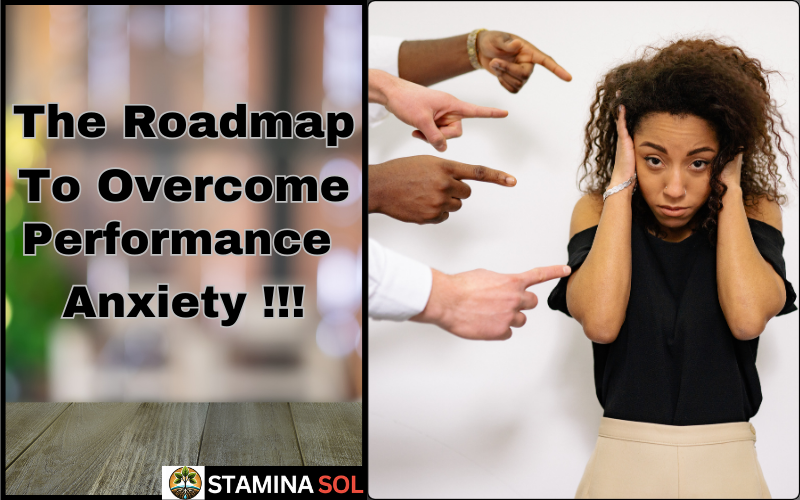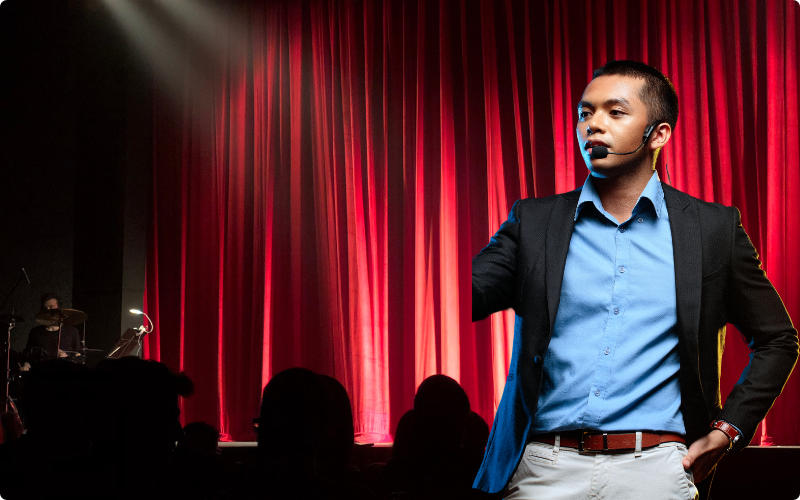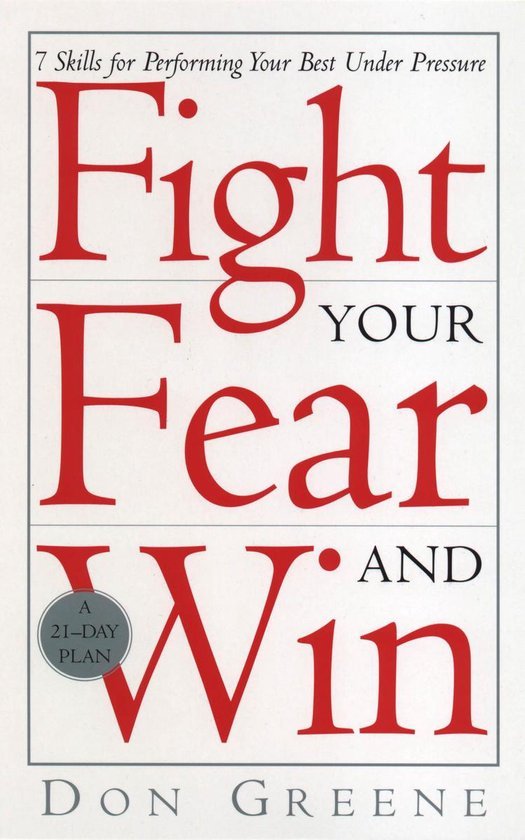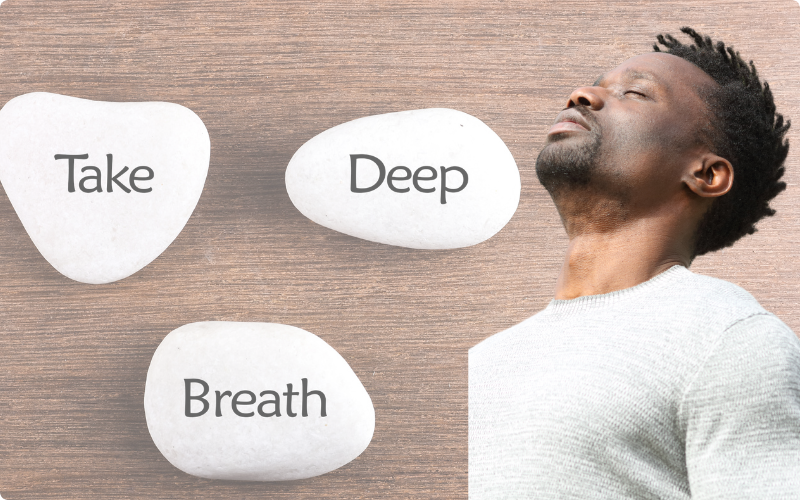
Stage fright or performance anxiety, is a common fear that affects many individuals, from public speakers to performers. It is characterized by intense anxiety and nervousness that can manifest in physical symptoms and negatively impact one’s ability to perform.
Whether you’re giving a presentation at work, performing on stage, or even engaging in intimate situations, stage fright or performance anxiety can be a debilitating experience.
In this article, we’ll explore the stage fright symptoms, performance anxiety causes, and types of stage fright, as well as provide you with seven easy and quick steps to overcome this fear and boost your confidence, make sure you are ready for any important events in your personal live or your professional career.

1. Stage fright definition: Stage fright Is a common fear characterized by intense anxiety and physical symptoms that can affect anyone from public speakers to performers and even in intimate situations. Understanding the symptoms, causes, and types of stage fright is the first step in overcoming it.
2. To combat stage fright or performance anxiety, start by setting a clear, positive intention for your performance and choose a focal point to redirect your nervous energy. Practice mindful breathing and progressive muscle relaxation to calm your body and mind.
3. Develop a process cue a short, guiding phrase that aligns with your intention and repeat it internally to stay focused and grounded during your performance. Find your center by focusing on a spot just below your navel to further increase your sense of stability.
Stage fright or performance anxiety can manifest in various physical and psychological symptoms, including:
There are several factors that can contribute to the development of stage fright or performance anxiety:
Stage fright or performance anxiety can manifest in various situations and contexts, including:
Public speaking: Fear of speaking in front of an audience, whether it’s a small group or a large crowd, is one of the most common forms of stage fright or performance anxiety. This can include presentations, speeches, or even participating in meetings.
Musical performances: Musicians, singers, and dancers may experience stage fright when performing in front of an audience. The pressure to execute flawlessly and the fear of making mistakes can contribute to anxiety.
Acting: Actors may experience stage fright when performing on stage or in front of a camera. The pressure to embody a character and deliver a convincing performance can be overwhelming.
Sexual performance anxiety is a type of stage fright that specifically relates to intimate situations. It is the fear, anxiety, or nervousness felt when engaging in sexual activities with a partner. This type of performance anxiety can affect both men and women, causing physical and psychological symptoms that can interfere with sexual enjoyment and satisfaction.
For men, sexual performance anxiety can sometimes lead to premature ejaculation, which is when a man ejaculates sooner than he or his partner would like. If left untreated, this anxiety can escalate and contribute to erectile dysfunction, a condition where a man has difficulty achieving or maintaining an erection suitable for sexual intercourse. here
Don Greene, a leading sports psychologist, has coached the U.S. Olympic swim team, served in the U.S. Army Special Forces as a Green Beret, and trained the San Diego Police SWAT team. With his extensive experience working with high-pressure situations, he is an expert on performance anxiety. In his book “Fight Your Fear and Win,” which Is a most read book.
Greene outlines seven steps to combat stage fright or performance anxiety, which have proven invaluable to many, including myself. These strategies have helped me during my own presentations, and now I want to share them with you.

Before any performance or presentation, it’s crucial to form a clear intention. This means setting a specific goal or desired outcome for your performance. When your thoughts are scattered, and you’re rushing around, it’s almost impossible to feel confident. By focusing on a single, clear intention, you can eliminate confusion and chaos, centering yourself and boosting your confidence.
Your intention should be positive and specific. For example, if you’re going into a negotiation, your intention might be “get the buyer to sign and stay firm on numbers.” If you’re auditioning for a role, your intention could be “play my heart out and hit all the right notes.” Avoid using negative words like “don’t” or “no” in your intention. Instead of saying “don’t mess up,” frame it positively as “stay confident.”
Forming a clear intention is like setting a destination for your performance journey. It gives you a sense of purpose and direction, helping you stay focused and motivated. When you have a well-defined goal in mind, you’re less likely to get sidetracked by nerves or distractions. Your intention acts as a guiding light, reminding you of what you want to achieve and why it matters to you.
One of the most effective techniques for managing stage fright or performance anxiety is to pick a focal point. This is an unimportant, far-off point in the back of the room or auditorium where you can mentally direct your nervous energy. By redirecting your anxiety to this focal point, you can alleviate the physical symptoms of stage fright and maintain focus on your performance.
If you’re unsure about the room you’ll be in or are traveling to a new location, you can also use a grounding prop as your focal point. This can be a pen or any other small object that you can imagine flinging your nervous energy towards. Once you’ve mentally released your anxiety onto the prop, you can set it down on a podium or table, tricking your brain into thinking you’ve let go of the nervousness.

Breathing is a powerful tool in combating stage fright or performance anxiety. When we’re nervous, we often take shallow breaths or even hold our breath without realizing it, exacerbating the cycle of anxiety. By consciously focusing on your breath and breathing mindfully, you can counteract the physical symptoms of stage fright.
To breathe mindfully, start by closing your eyes. Inhale deeply through your nose and exhale through your mouth, pushing out your belly with each breath. This deep belly breathing helps to center and calm your mind and body. Take a few moments to focus solely on your breath, allowing it to anchor you in the present moment.
When we experience anxiety, our bodies tend to tense up. We clench our jaws, tighten our shoulders, and squeeze our arms to our sides. This muscle tension can worsen the symptoms of stage fright and hinder our performance.
To counteract this, you need to progressively relaxing your body, starting from your head or toes and working your way through each muscle group.
For each area of your body, take a deep breath and consciously relax the muscles. Think to yourself, “relax my feet,” “relax my shins,” “relax my thighs,” and so on. This progressive relaxation exercise not only physically relaxes you but also serves as a mental distraction, preventing you from dwelling on worst-case scenarios or last-minute worries.
In addition to progressive muscle relaxation, it is important to find your physical center to help ground yourself. This center is located approximately two inches below your navel and two inches below the surface of your belly.
By focusing on this spot and imagining it as a source of calm and stability, you can further reduce anxiety and increase your sense of centeredness.
You can combine this technique with the previous step, focusing on relaxing your center with each breath. This powerful combination of physical and mental relaxation can help you feel more grounded and prepared for your performance.
In the first step, we discussed setting a clear intention for your performance. A process cue is a mental or physical reminder of how you want to achieve that intention. It’s a short phrase or mantra that encapsulates the way you want to approach your performance.
For example, if you’re an interviewer, your process cue might be “smile and ask great questions.” If you’re a violinist, your process cue could be “smooth and good tempo.” For public speakers, a process cue like “keep it positive and engaging” can be helpful. Your process cue should align with your intention and serve as a guiding principle throughout your performance.
Repeat your process cue internally as you prepare, transition, and perform. It will help you stay focused, grounded, and connected to your intention, even in the face of anxiety or nervousness.
Remember the focal point we discussed in step two? This is where you’ll mentally direct your excess nervous energy and anxious thoughts. Simply telling yourself not to be anxious is rarely effective. Instead, by redirecting that energy to your focal point, you can experience a sense of relief and lightness, as if you’ve thrown off a heavy backpack.
As you begin your performance or feel anxiety creeping in, take a moment to mentally gather your nervous energy and hurl it towards your focal point. This powerful mental exercise can help you combat nerves and maintain focus on your performance.
This visualization technique can be incredibly effective in managing stage fright or performance anxiety because it gives you a sense of control over your anxiety. By actively directing your nervous energy away from yourself and towards a neutral focal point, you create mental distance between yourself and your fears. This distance allows you to approach your performance with greater clarity, focus, and confidence.
Remember, this technique may take practice, but with time and consistency, you can train your mind to redirect anxious energy and maintain composure under pressure. Embrace the power of visualization and use it to your advantage whenever you feel stage fright starting to take hold.
Stage fright or performance anxiety is a common experience that can affect individuals in various situations, from public speaking to intimate encounters. By understanding the symptoms, causes, and types of stage fright, you can begin to develop strategies to overcome this fear and boost your confidence.
The seven easy and quick steps outlined in this article provide a systematic approach to managing stage fright or performance anxiety. By forming a clear intention, picking a focal point, breathing mindfully, releasing muscle tension, finding your center, repeating your process cue, and directing your energy, you can effectively combat anxiety and deliver your best performance.
Remember, overcoming stage fright or performance anxiety is a process, and it may take practice and patience. Be kind to yourself and celebrate your progress, no matter how small. With time and consistent effort, you can build your confidence and master the art of managing performance anxiety.
So the next time you find yourself facing a challenging performance or presentation, take a deep breath, remember these seven steps, and know that you have the tools and strategies to overcome stage fright and shine in the spotlight.
Stage fright is the fear or anxiety felt when performing or speaking in front of an audience.
Stage fright is very common, affecting up to 75% of the population to some degree.
Stage fright is also known as performance anxiety.
Stage fright does not have an exact time frame , it depend on how big or important the event or the audience is. It can start minutes, hours, days, or even weeks before a performance or presentation in public.
You can fight stage fright by preparing well, practicing relaxation techniques, and focusing on your message.
Stage fright or performance anxiety happens due to fear of judgment, lack of confidence, or past negative experiences.
Yes, stage fright and performance anxiety are two terms that refer to the same experience the fear or anxiety felt when performing or speaking in front of an audience. Whether you call it stage fright or performance anxiety, it describes the nervous feelings and physical symptoms that can occur before or during a performance, presentation, or other high-pressure situation.
Join a vibrant community committed to improving overall wellness and boosting confidence in intimate moments.
© 2025 All Rights Reserved By STAMINA SOL.